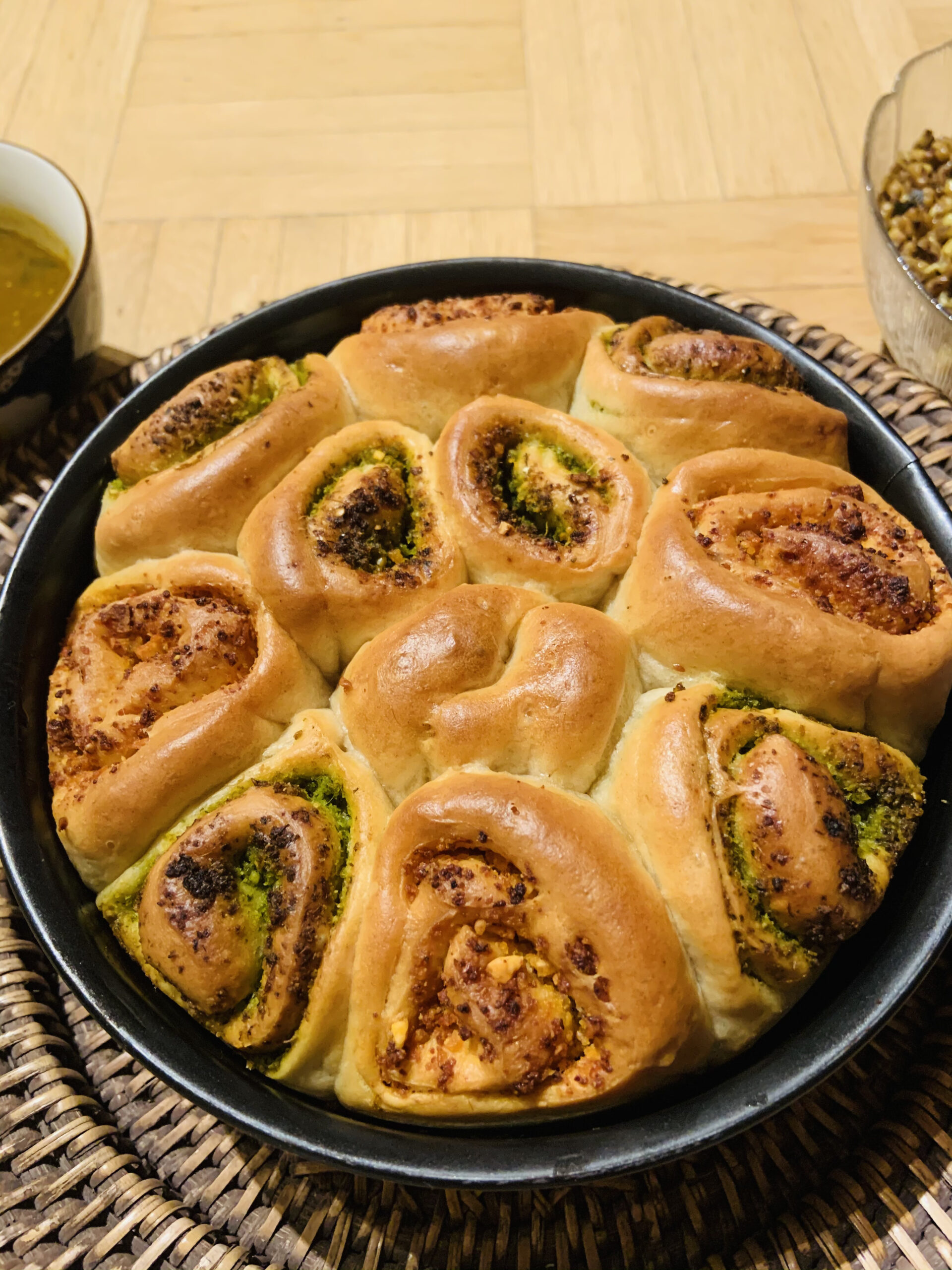Chutney waale Paav
The term Laadi Paav reminds a foodie of a luscious, fluffy, golden crusted bread that is typically served with Paav Bhaji, Misal Paav, Anda Bhurji. This is my take on the classic Laadi Paav which goes really well with gravy-based dishes. In this variant of the Laadi Paav, I have substituted All Purpose Flour with the Spelt Wheat Flour or Dinkelmehl as it gives the bread a subtle, rustic flavor.


INGREDIENTS:
GARLIC CHUTNEY
20-25 pods of garlic
2.5 cups of dry coconut/ dessicated coconut
15-20 dry red chillies
2 tbsp. sesame seeds
Salt – acc. to taste
GREEN CHUTNEY
2 cups of coriander (including tender stems)
1 cup of freshly grated coconut
1 medium sized pod of garlic
small piece of ginger
Roasted Jeera/ cumin powder
1/2 tsp. lemon juice
Salt and sugar – acc. to taste
LAADI PAAV
750 gms. Maida/ All Purpose Flour/ Dinkelmehl (Spelt flour)
375 ml. water
90 ml. oil
10 gms. salt
30 gms. fresh yeast
15 gms. sugar
Makes – 15/16 Paav
Method:
Garlic Chutney:
In a flat bottom pan, dry roast grated coconut, red chillies and sesame seeds seperately till they change colour. Set them aside to cool. Add this mixture to a grinder along with the garlic pods and the salt. Grind to a coarse consistency. Store the Garlic chutney in an air-tight jar since it has a strong pungent smell.
Green Chutney:
In a grinder jar, mix all the ingredients and grind it to a smooth consistency. Abstain from adding water to this. In case you need to, rather add a few drops of oil to this for the mixture to grind well.
Laadi Paav:
Mix the dry ingredients well in a large container. Please bear in mind that the dough will double in size when left to rise. In the meanwhile, use half of the water to make the yeast slurry. For this, warm the water to a lukewarm temperature and place it in a bowl. Add the sugar to this water and stir well. Then add the yeast to it and leave it to rest in a warm place for about 7-8 minutes. The safest way to do this is to place the bowl inside an oven. After 7-8 minutes, the mixture should look frothy. This is a good sign since it signifies that the yeast is alive and active.
Once the yeast slurry is ready, then start adding it along with the water to the dry mix and kneading the dough well. Fold the dough multiple times in order to activate the gluten in the dough – this makes the bread soft and fluffy. Add oil in the end since it helps the dough to come together well. Once the dough has a soft texture, cover the container with a wet cloth or aluminium foil and set it aside to rest for a good 45-50 minutes (or till the dough has doubled in size). In places with cold temperatures, placing the container inside an oven with the light left on works wonders. In the meanwhile, take a generous amount of each of the chutneys in seperate bowls and mix them with well with some oil so they aren’t too dry and easy to spread.
Once the dough has doubled in size, divide it into two parts. Place one part back in the container and cover it with the wet cloth again. Roll out the other part with a rolling pin till it is about 1.5-2 cms thick. Once rolled out, spread the garlic chutney-oil mix on it evenly. Then roll it into a tight log. Tuck in the ends well. Cut this log into roughly 7-8 equal-sized pieces. Line them inside a greased cake tin with the chutney covered part visible on the top. Repeat the same process with the green chutney. For the sake of optics, you can also line the cake tin alternately with one portion of garlic chutney and one of green chutney each. Mist the top with some water and cover it again with a wet cloth or an aluminium foil and leave it to rest for about 30-45 mins. or till the buns have fused together and sit snug inside the cake tin.
Pre-heat the oven to 220 degrees celsius. Place the cake tin inside and bake it for about 15-17 mins. (The time varies from place to place, consistency of the dough, temperature etc.) Once the Paav is ready, take it outside the oven and brush it with some oil. Take away the outer cover of the cake tin. and allow the Paav to cool down before serving.
Notes:
– Please make sure that you take a cake tin big enough that allows the dough to rise well and spread out since the volume of the Paav increases while baking. If the cake tin is too small, you run a risk of being left with a raw dough.
– This variant of the Laadi Paav goes really well with all sorts of gravy-based dishes and grants the gravy a unique flavour.
– You can also make this Paav with other stuffings of your choice like Jalapenos + Cheddar Cheese + Caramelised onions. To make caramelised onions, slice 5-6 medium sized red onions and sauté them in olive oil/ butter (or a mix of both) on medium heat till they turn translucent brown. Then add a tsp. of sugar, some salt and about 2 tbsp. of balasmico cream.
